Across Lake Ontario by Stand-Up Paddle
From St. Catharines to Toronto (80 km)
I finished my shift at work at 11pm, drove to Port Dalhousie in St. Catharines, and shortly I was on the water leaving the docks of Harbour Marina. It was Saturday September 27, 2014 – 1:40am.
After meticulous preparations, physical training, and endless waiting for the right weather, I finally set out to cross Lake Ontario by Stand-Up Paddle, solo, and without a support boat. My plan was to paddle from St. Catharines along the shore to Fifty Point, then to cross the lake to Oakville, and then to continue along the shore to Toronto, Humber Bay Park West. The plotted path of the whole trip was about 80 kilometers, and I estimated roughly 20 hours of continuous paddling.
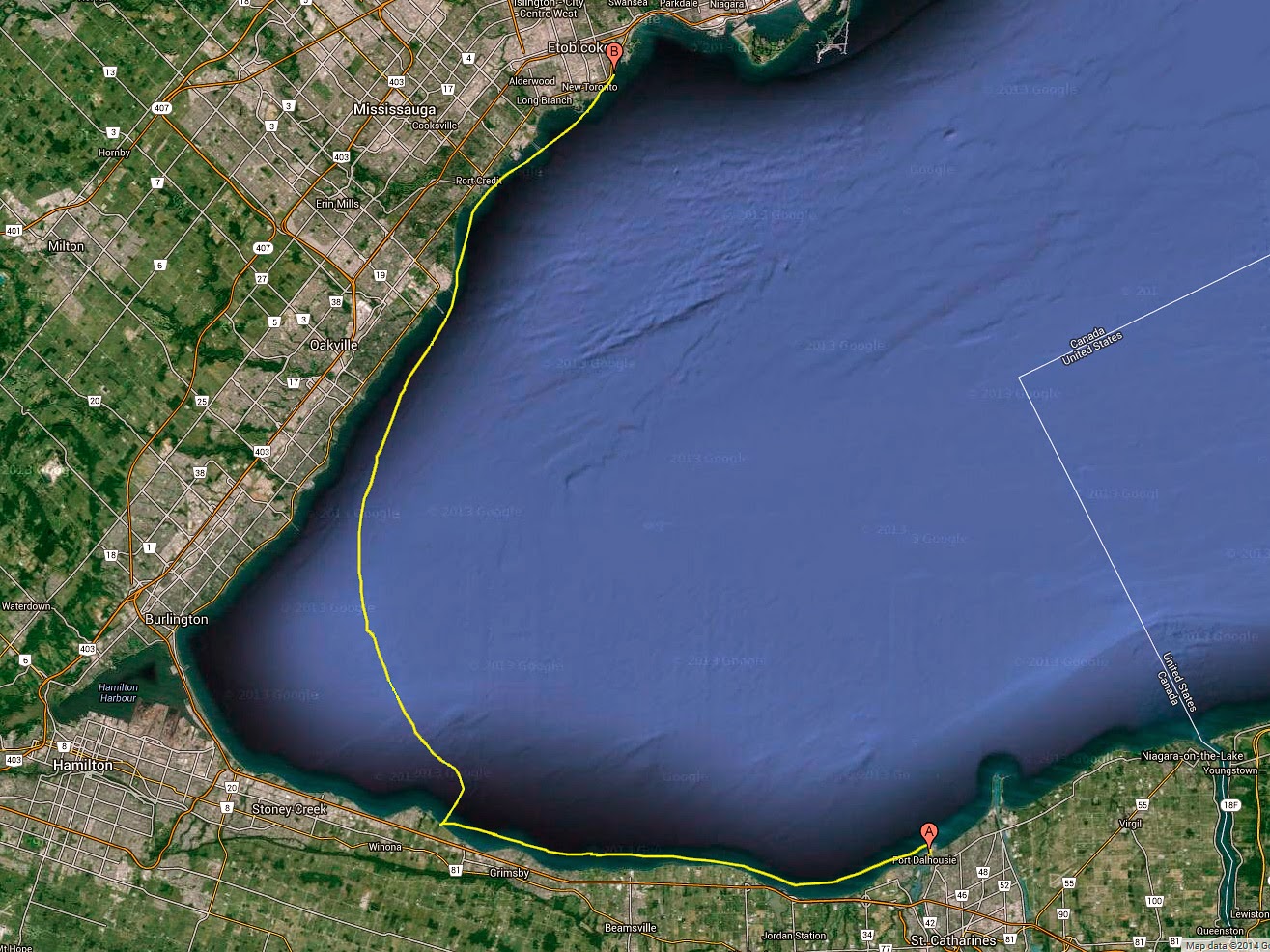
The night was young, the stars were bright, and the water was smooth as butter. My inflatable Stand-Up Paddleboard equipped with proper marine navigation lights gleamed into the darkness and I enjoyed the smell of the extra-large coffee standing on the board between my feet. The long journey of self-inflicted physical and mental massacre was just beginning.
As soon as I left the marina, I noticed a big commercial vessel just a few kilometers off the coast heading north. I was amazed by the size of that ship as well as how well lit it was. It was like a gigantic Christmas tree on the water. Paddling alone in the dark, I mused myself by trying to recognize landmarks along the coast. I could clearly see the distant red lights of the AM-radio antenna farm in Grimsby but nothing further across the lake. The beacon of Harbourside Marina in Jordan Harbor was flashing green far in the distance and I would use it as my navigation aid for the next hour and a half. The “Christmas Tree” vessel seemed to be passing me very slowly and I relished hearing my paddle monotonously breaking the silky surface of the water. It wasn’t until 15 minutes later that I finally realized, with a great feeling of humiliation, that the commercial vessel on my right, was actually anchored! The angles, the distances, and the whole perception of things floating on the water at night were totally misleading my senses.
My VHF radio occasionally broke the silence and came to life. I could hear a boat controller communicating with three ships transiting through the locks in Welland Canal. I remembered the numbering of the locks and so I was able to decipher that the boats were headed south to Port Colborne. This was good news for me as I didn’t have to worry about them crossing my path later during the day. I took another sip of my cold coffee and felt like million bucks.
These huge commercial vessels that seesaw Lake Ontario between Port Weller, Hamilton, and Burlington were my major worry. It wasn’t the wake behind these beasts that I was concerned about, it was the mere fact that I could easily be run over. A person standing on a paddleboard must be very hard to spot at the best of times, let alone when looking into the sun or when not looking at all. To mitigate this danger, I familiarized myself with the commercial routes and the boat traffic management system on the lake. I learned, among other things, that Lake Ontario and the Welland Canal are divided into three traffic control sectors, with vessel movements in each sector controlled by a traffic controller who provides information on vessel locations, lock chamber status, marine weather, and so forth. In the end, I decided to buy a marine radio so that I could listen in and have better situational awareness about what was going on around me. Additionally, I would have another means to contact Canadian Coast Guard in case I ran into trouble. Altogether, I had three different ways to call for help or to scramble search and rescue; my iPhone, VHF Marine Radio, and SPOT satellite messenger.
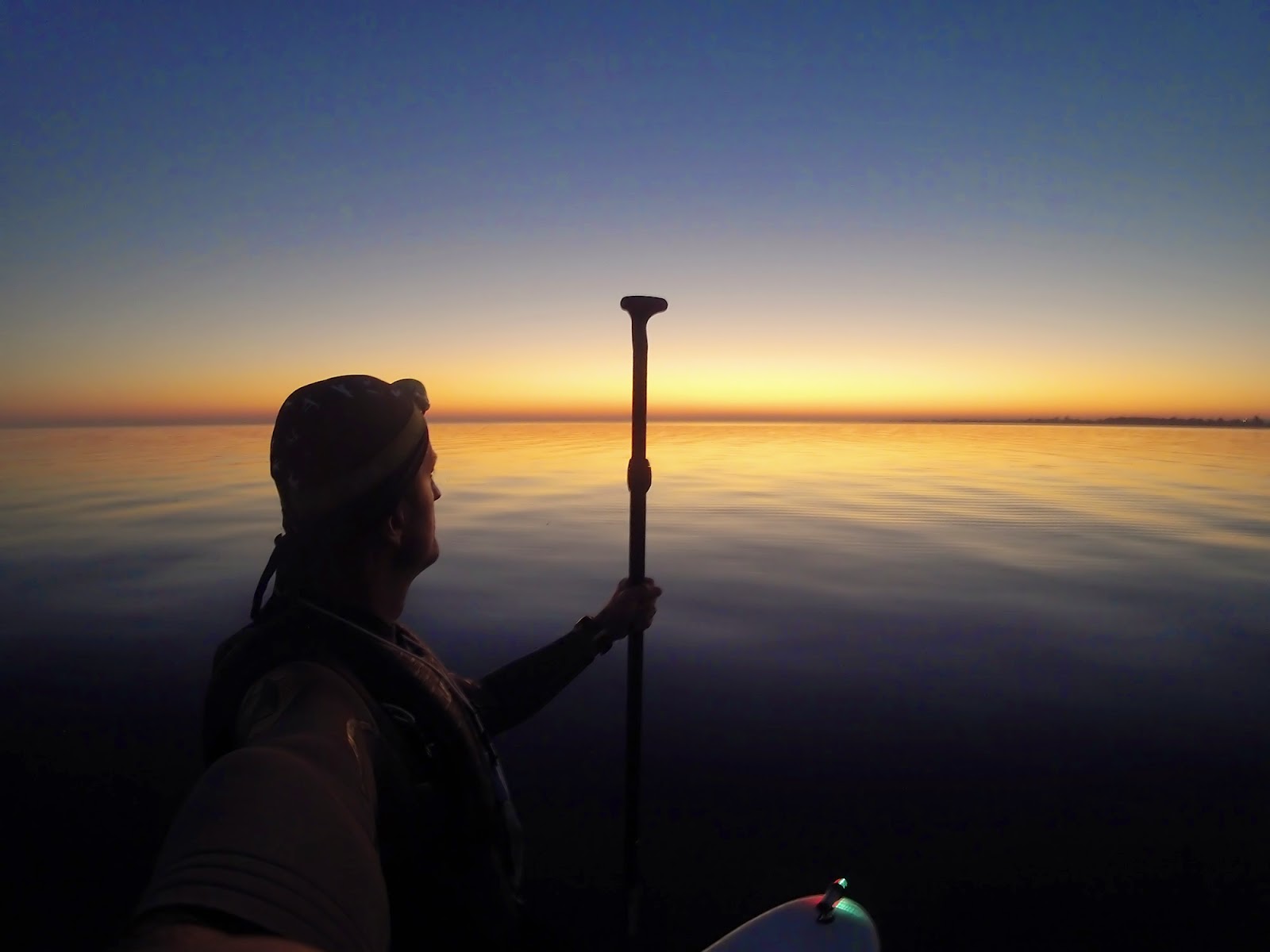
There is not much happening on the lake at night. The Orion constellation rises in the west and the Big Dipper slowly sets in the east. I saw a few meteorites shooting through the sky and the ISS passing overhead. As I kept paddling, I overheard a transmission on my radio that a dead body had been spotted in one of the locks. After a short flurry of communications, all boat operations in Port Colborne were suspended, the recovery boat was dispatched, and the poor guys in the vessels got stuck on the Canal until the situation was resolved. In the end, it took the authorities about four hours to resume operations. By that time I covered more distance on my paddleboard than any vessel in Welland that night!
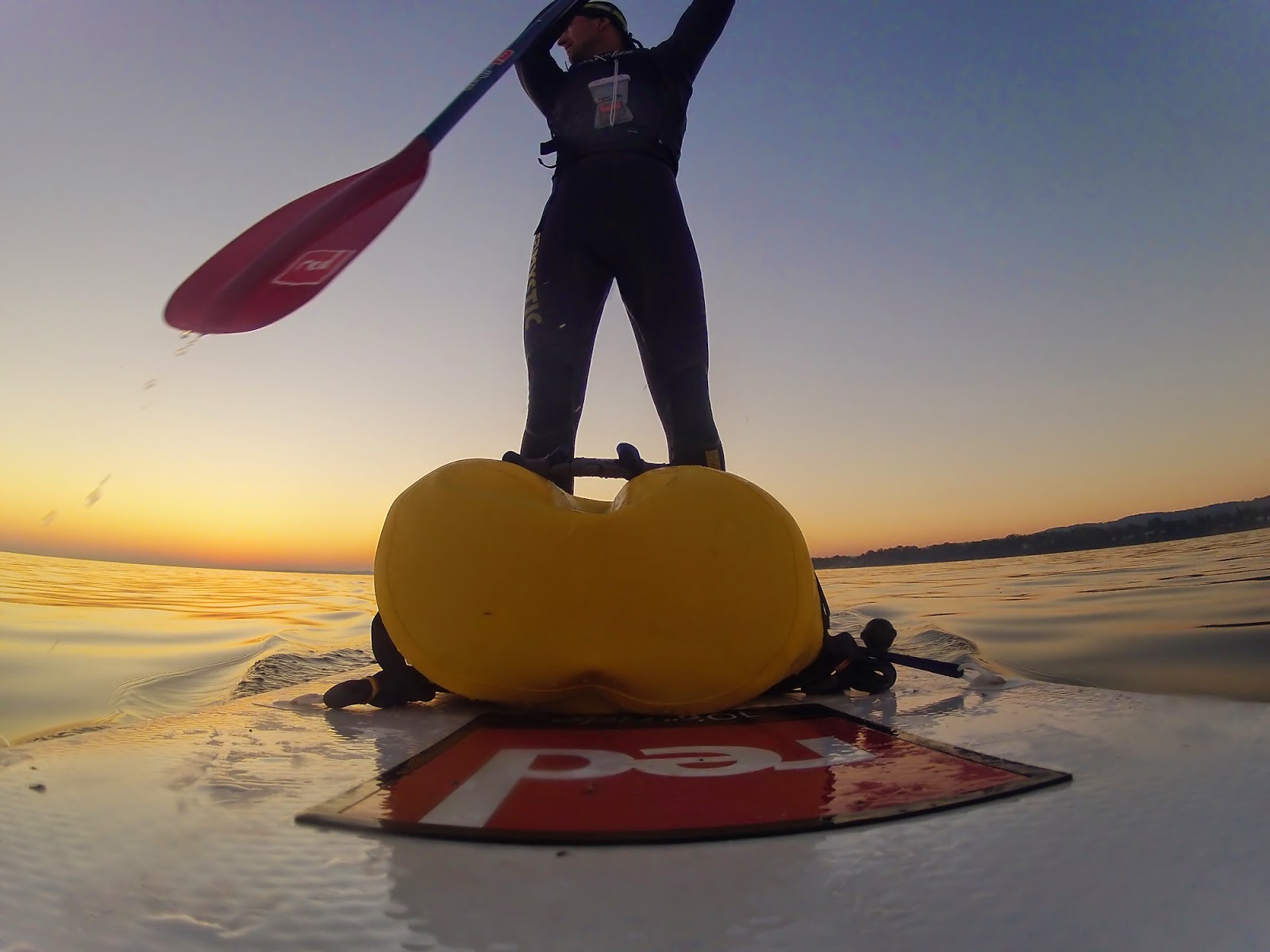
At about 6:30 am, the horizon started to light up and the long awaited sunrise was on the menu. I was close to Grimsby and marveled at the beautiful houses on the waterfront. The next 30 minutes of my paddling were the most beautiful moments of the whole trip. I was suspended in the sea of gold. The lake was totally still as far as I could see and I was quietly moving through this beautiful metallic-like substance that was changing colors minute by minute. I stopped paddling and tried to absorb it all. Shortly after 7am, a big crimson disk began to rise straight from the water behind my back. There was no cloud in the sky nor any haze to spoil this unbelievable show. I sat on my SUP motionless. I didn’t want to make a single ripple or a sound to interfere with the Universe. I felt rich.
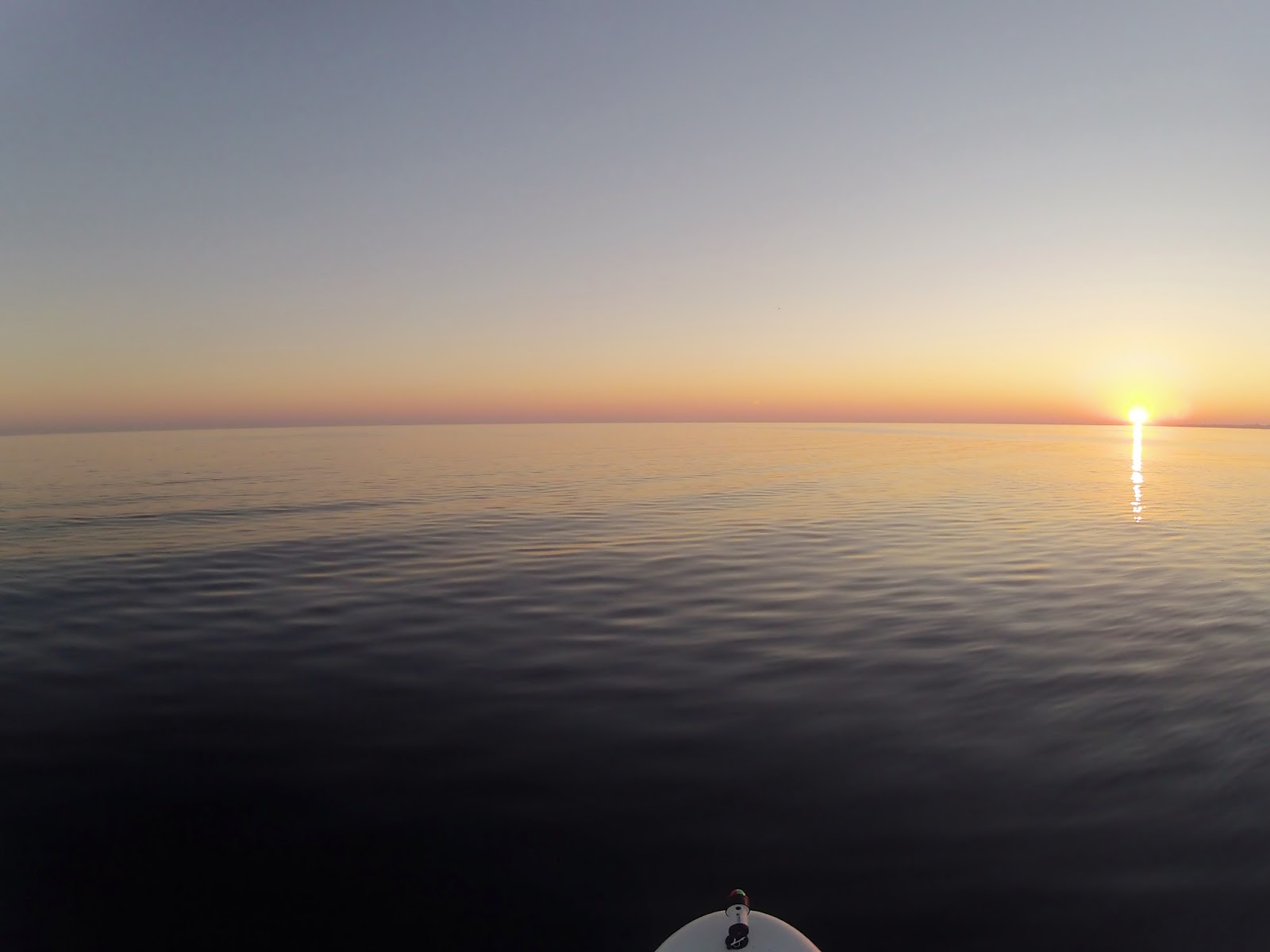
I made it through the night and Fifty Point was in my sight. By then, I had paddled for 6 hours and covered 30 kilometers. Surprisingly, I felt fresh considering that I hadn’t slept for 22 hours. As I was slowly approaching a beach that I knew from my kitesurfing sessions, I noticed a red flag flying above Winona Shooting Range and that made my heart sink. My mission was possibly over. The red flag is a signal that the shooting range is active, in which case the area on the water designated by yellow-white buoys is not to be entered in any circumstances. When I saw the buoys stretching out into the lake as far as I could see, I knew I was in trouble. My passage to the north was cut off. Then I saw a soldier waving frantically another red flag and I knew they were serious. I landed my SUP right under the sentry, climbed a few boulders up to the shore, and had a chat with the guy. “Absolutely no way to pass through until 12:30pm, sir” was a clear message that was not negotiable. “OK, I will paddle around then, just make sure you don’t shoot me” was my similarly determined answer and I went back down to my SUP. In fact, I had no idea what to do. The buoys seemed to never end from my vantage point and to portage around the shooting range was out of the question. I sat down on the boulders, ate, drank, changed from my wet suit to shorts, and pondered my fate. “The hell with it. If I want to paddle 80 kilometers, a few extra miles should make no difference.” I repacked my gear on the SUP and cast off shortly before 9:45am. I obediently followed the buoys out to the lake while listening to the repeated salvos at my back. I felt like a rabbit in a field. When I finally spotted the last buoy, I knew this obstacle was going to be defeated. As a matter of fact, my renewed energy made me feel a bit rebellious and I disregarded the last two buoys and cut the corner of the restricted area by good 200 meters. The battle was still raging behind me but I didn’t pay any attention to it anymore. I was on the open water now and the shore I was headed towards was about 25 kilometers away.
Obscured in the haze, I could faintly see a few high-rises in Oakville. At no point of my trip so far had I been able to see Toronto or the CN Tower. I could see and smell Hamilton all right but that wasn’t a place of interest for me. My GPS watch pointed towards the haze obscured horizon and so I paddled away to the big and possibly dangerous unknown.
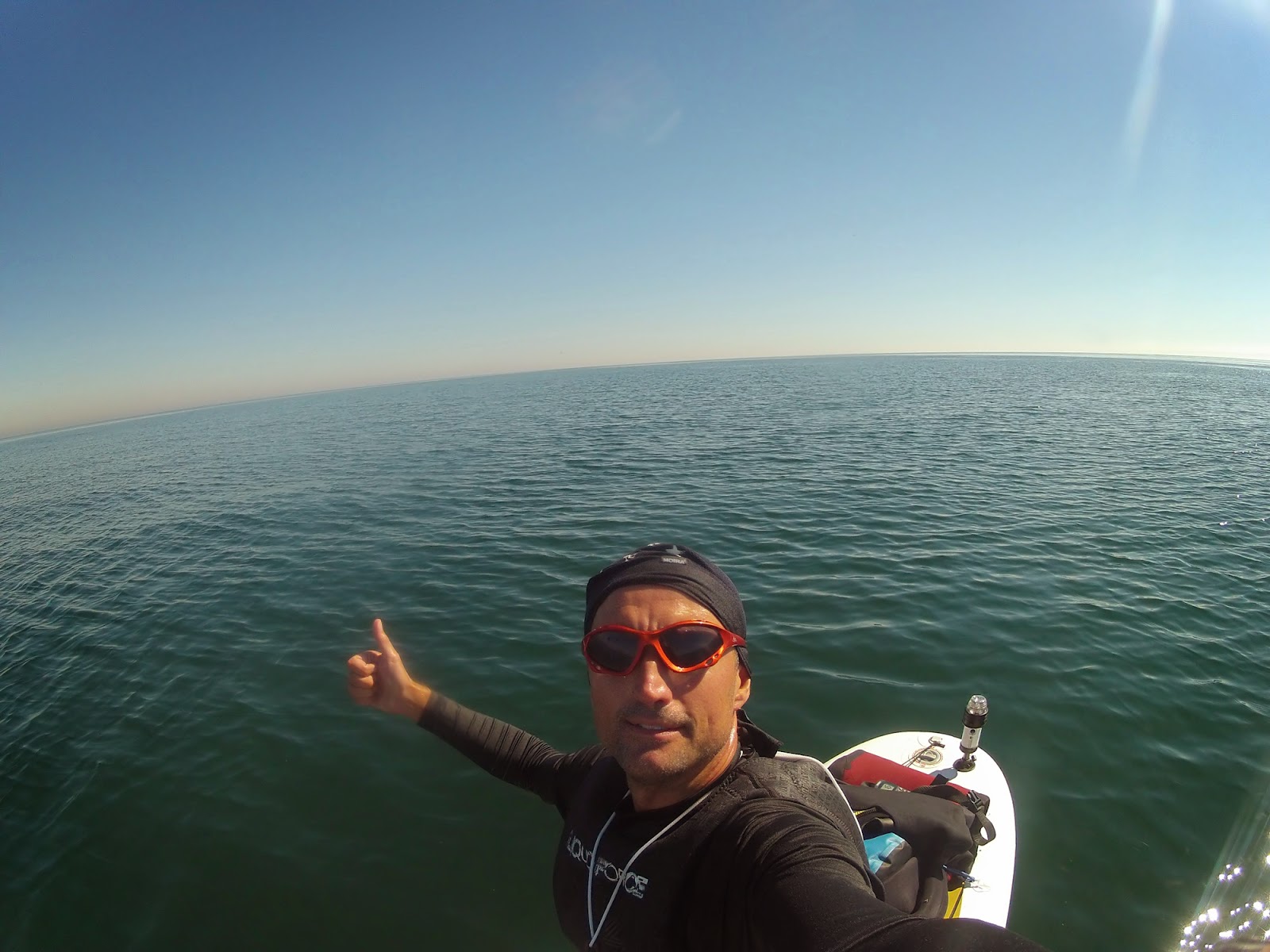
The time was passing by and I paddled from one GPS waypoint to the next. I had created a system, naming these waypoints to know exactly where I was. For example: 5D210H meant that I was 5 kilometers away from Fifty Point and the closest shore would be on heading 210 degrees in case I got into trouble and had to bail out. Thanks to my own APP which I programmed and uploaded into my watch, I also knew how many meters I was drifting away from my predetermined track. This information became invaluable as I realized there was absolutely no visual reference on the lake to determine whether I was actually making any progress towards the distant shore. In fact, the water currents could easily carry me in a different direction without my knowledge.
Everywhere I looked, there was water. It was scary and exciting at the same time. A few motor boats passed in the distance but so far, I hadn’t had any visitors during my trip. I occupied my mind by scanning the shore constantly for big vessels that could become a threat and for landmarks that I could recognize. No signs of Toronto at all, only Oakville was visible. Then my radio came to life and I heard a call from a vessel heading towards Burlington. I looked towards Port Weller but couldn’t see a thing. It was shortly before noon and I was roughly 5 kilometers away from the midpoint of my crossing. I needed to stop for a break but my nerves wouldn’t let me. I had to paddle, I had to do something to ease my nerves from not knowing whether I was on a collision course with that boat or not. Five minutes later, I finally spotted a ship on the horizon. It was at my 4 o’clock, heading my way. I stopped paddling and watched the boat closely. It was still very far away but projecting its path to Burlington, I believed that I should be okay, that it should pass on my right. I relaxed a bit but I felt extremely exhausted. I needed to stop and replenish my body. The problem was that I was afraid to sit down on my SUP. If somebody on the vessel happened to spot me, they would surely call 911, reporting a castaway sitting on his life raft. I figured I had to keep paddling to show some strength and purpose.
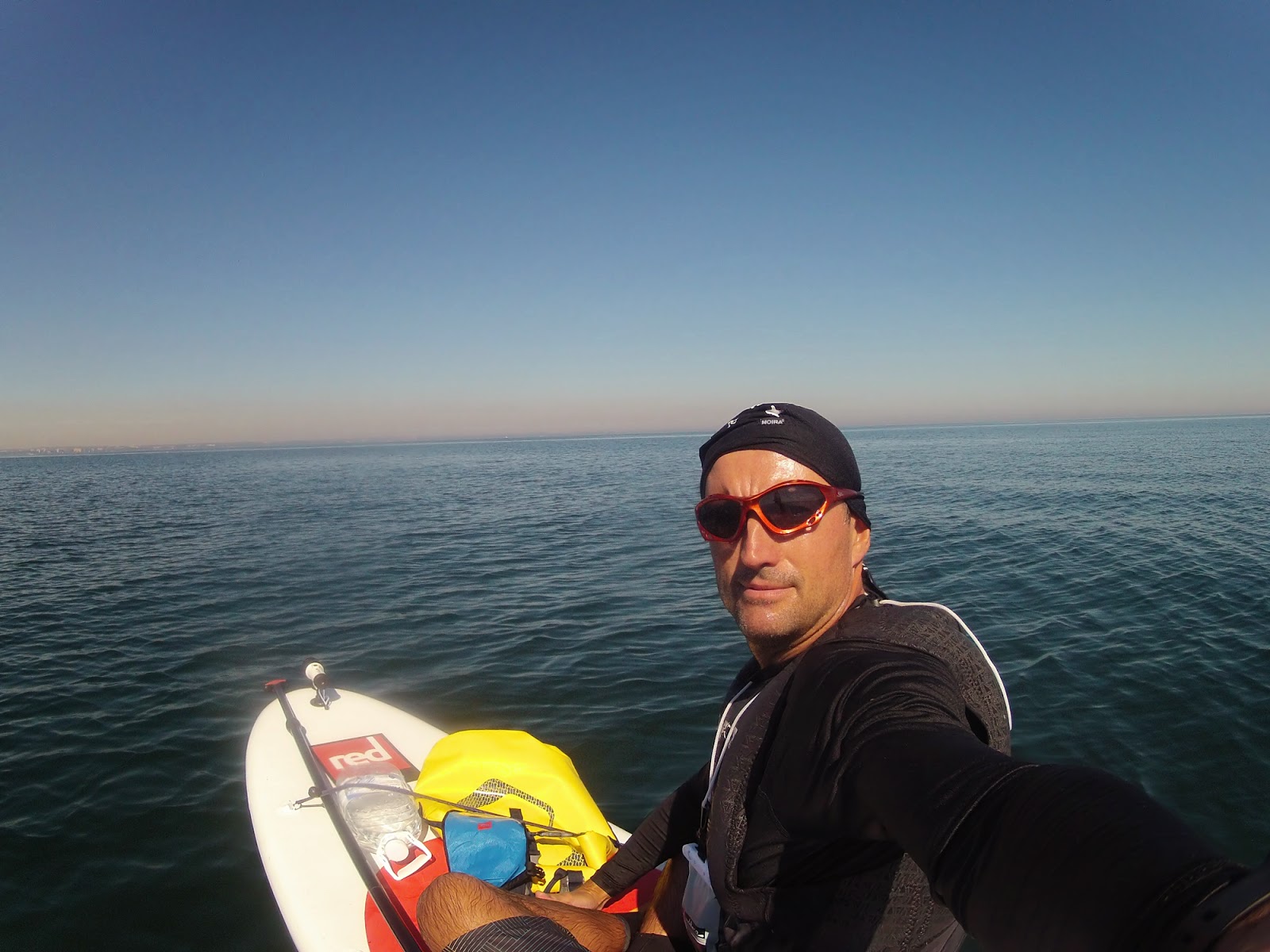
For the next 45 minutes I paddled and watched the vessel like a hawk. I was unable to fully relax until the boat was close enough for me to clearly see that I wasn’t anywhere near in its path. When the ship finally passed by, I estimated its closest distance somewhere between 3 to 5 kilometers. Mentally and physically exhausted I sat down on my SUP; I was almost exactly in the middle of the lake. What were the chances? This was exactly one of those hazardous scenarios that I had run through my head during my preparations. Without my VHF radio, I imagined this episode would have shaken me right to the bone. I would have had no clue about the ship’s intended path, and with virtually no references for me to judge distances, angles, and directions, I wouldn’t have known where and whether I should paddle out of its way.
And there I was, balancing on my inflatable “raft” right in the middle of nowhere. Surreal! Just water and me. My life depended entirely on just a few items I had with me. The simplicity of being dead or alive was striking. I looked around and marveled at my surroundings. It was one of the strongest moments of my life, the most amazing rollercoaster of emotions, and an unimaginably strong spiritual feeling. To solidify this special experience, I found enough courage to abandon my life raft and swim for a few minutes. Slowly, the urge to get the hell out of there started to overpower me and so I left this unmarked “chapel of inner peace” and paddled away.
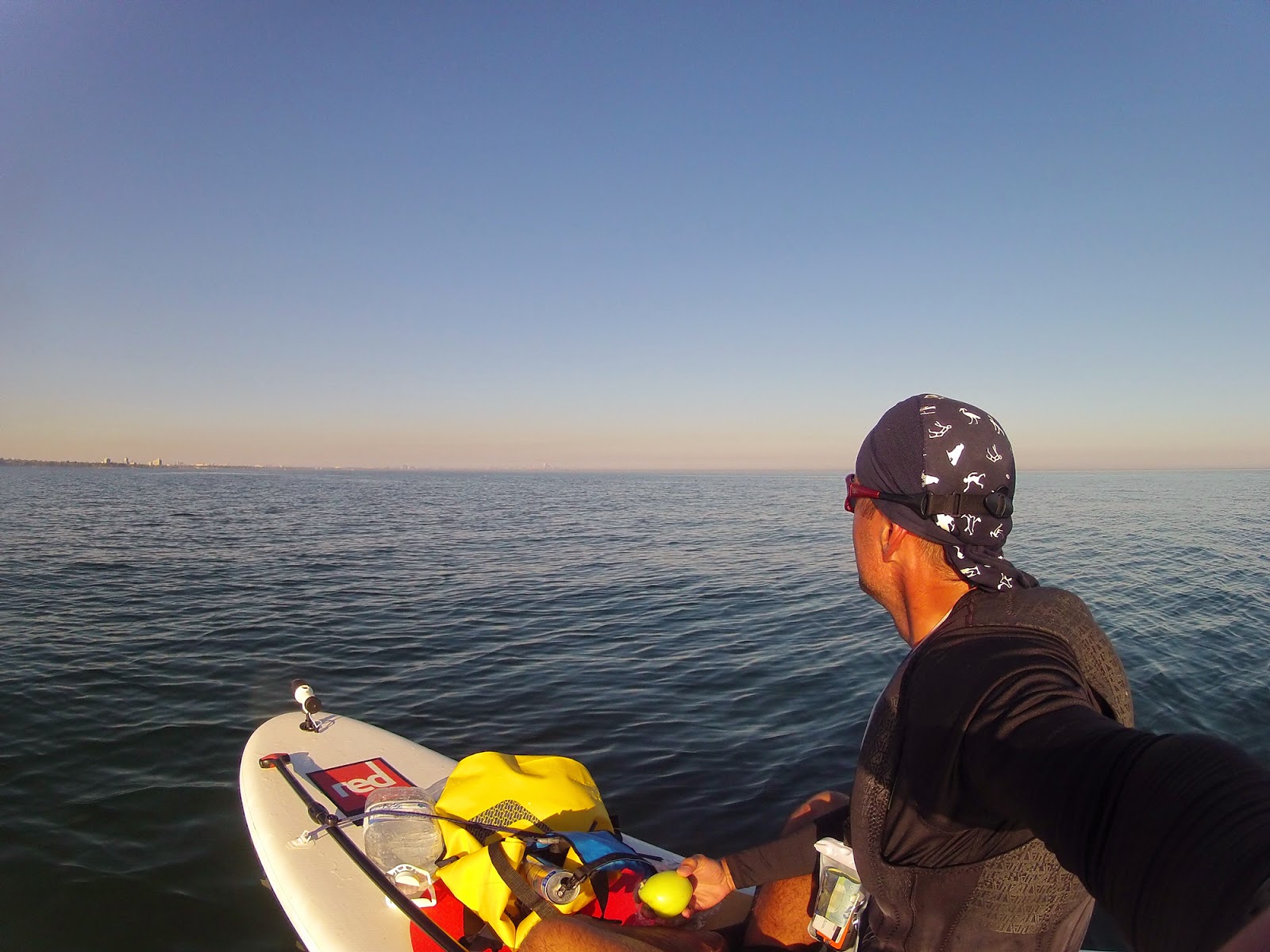
A few kilometers later I spotted a sailboat motoring towards me. Soon it was clear that I would finally have some visitors. When the boat was close enough, I hollered if the lunch was ready. They laughed and replied: “Where would you like to have it served?” Then the inevitable question came, I completely floored them with my itinerary, we waved good bye, and the solitude resumed. This human touch away from the distant shores filled me with renewed energy. I paddled for hours before I started to feel tired again. At one point I caught a glimpse of a long stack coming out of the haze little to my right. Finally, the CN Tower decided to reveal itself for the first time on this trip. It seemed so far though that I felt a little weak.
There was a barely noticeable breeze creating slightly ruffled patches of water here and there. Sitting on my SUP, as I ate, I watched various particles of pollen floating in the water underneath the surface. Then I noticed that these particles were moving away from me like if they were carried by a gentle invisible current. I immediately checked my GPS watch and memorized the exact distance from my next waypoint. When I finished my snack and was about to continue with my odyssey, I checked my watch again. To my great surprise, I moved nearly 200 meters within last 10 minutes. Wow! I was being carried at the speed of 20 meters per minute and the wind was almost nonexistent. Then I made a few quick calculations in my head and the whole truth finally revealed itself to me! I felt so foolish all of a sudden that I stood up immediately and started to paddle away. Even though I wasn’t in any danger, my newfound full appreciation of the wind power on the open water felt downright scary. With no obstructions in the way for kilometers on end, even the lightest of winds will eventually make the surface water move and create currents. It became apparent to me that a headwind as light as 10km/h could, under the right conditions, turn me easily into a gerbil in a wheel.

The gravity of my findings about my vulnerability made me paddle like there was no tomorrow. Then my calm reasoning prevailed, I slowly relaxed, and started to enjoy the day again. I started to pay more attention to the horizon and was pleased to see quite a few sailboats emerging along the coast. Even though I was still far away, I felt that civilization was within my reach.
And when I finally thought that I had seen it all for the day, I was hit with a major blow. The CN Tower, which was still partially obscured in the haze, wasn’t actually the CN Tower. It was just a smoke stack at the Oakville Refinery! “Cut my wrists or shoot me to end the agony!” Even though I was never lost during the trip, this massive landmark identification error was a perfect example of how quickly a person can get disoriented and misjudge the angles, distances, and time on the open water. Admitting defeat, I reactivated the navigation mode in my watch, and with my morale and determination completely destroyed, I continued paddling one stroke at the time.
It was nearly 3pm, I had 55 kilometers behind me, I had been paddling for 13 hours, and I hadn’t slept for 30 hours. I was entering the realm of completely uncharted territory in terms of my physical endurance. I had never paddled further than 50 kilometers and I had never stayed awake this many hours before. I didn’t feel any major pain except in my wrists and the tendons to all of my fingers. My feet felt little numb and swollen but I kept exercising them now and then.
As I paddled, the time was slowly passing by. In another hour or so, I guessed I was within three kilometers of the shore and I enjoyed the presence of many sail boats in the area. The late afternoon sun helped to penetrate the haze and the city of Toronto finally started to show its face on the horizon. In spite of my immense tiredness, I felt great! I had made it across the lake and that feat alone was totally incredible! This could very well be the first ever unsupported Lake Ontario crossing by SUP. By now, I knew I was going to complete this voyage no matter how much more pain it would take.
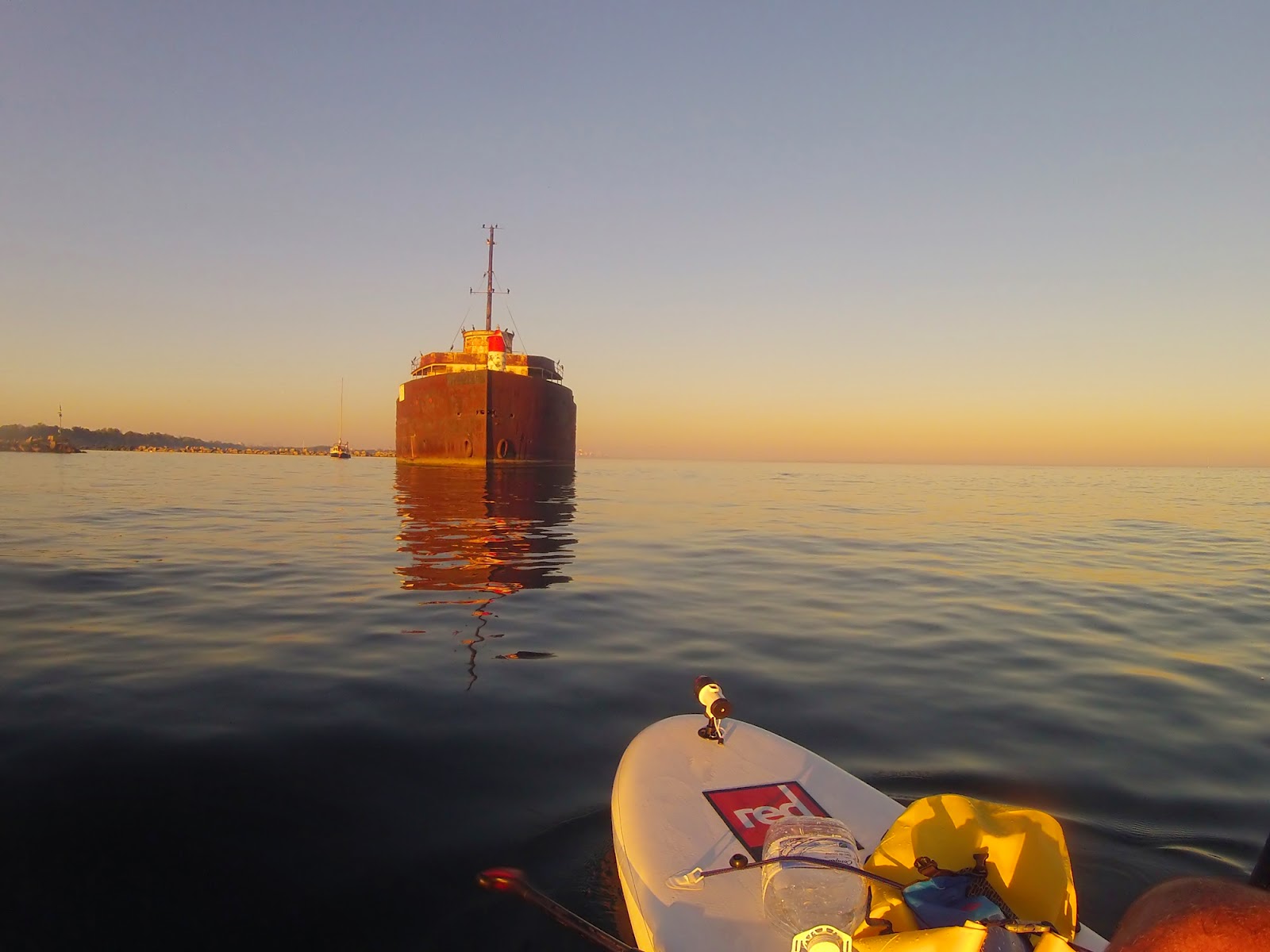
When I finally left the ugly Oakville Refinery behind, I had to lie down on my SUP and rest for about 30 minutes. My back was aching and the pain in my wrists was shooting all the way up to my elbows. Then I ate my last sandwich, energy bar, peach, and apple and paddled away. I passed the rusty ship at Port Credit Harbour while the setting sun was just about to put on another amazing show. I switched on my navigation lights and kept paddling towards Marie Curtis Park. I knew the coast very well from there on as I kite along those shores from Humber Bay quite often. When I passed the marina in Colonel Samuel Smith Park, the sky was pitch black and the stars were out again. I was on the homestretch and in just a few more kilometers I would coast to Humber Bay Park. It was hard for me to comprehend that I had been paddling for the whole day. When I looked towards St. Catharines, I saw nothing but water. The curvature of the Earth hid my starting point! I had a smile on my face because I knew I had accomplished the impossible: I reached the end of the horizon!
TRIP STATISTICS
____________________________________________
Total trip distance: 80.35km
Total time on the water: 19 hours 40 min.
Open Water* distance: 28km
Time on Open Water*: 5 hours 20 min.
Maximum speed: 7.2 km/h
Average paddling speed: 4.9 km/h
Average speed: 4.1 km/h
Wind speed: 0 – 4 knots
Calories burned: 5753 kcal
Time without sleep: 39 hours
Inflatable Board: redpaddle 12'
* - being offshore 2 kilometers or more.
____________________________________________
